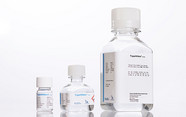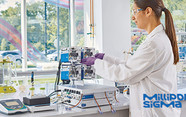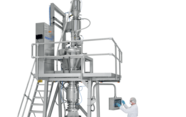
The Next Decade of Cell and Gene Therapies
Off-the-shelf allogeneic CAR-Ts, increased manufacturing productivity led by digital systems, and more; we ask experts about the future of advanced medicine.
| 5 min read | Opinion
As part of a special feature on the future of the pharmaceutical industry, we asked over 100 experts for their thoughts. Here, four experts share their view on cell and gene therapies
What we asked: “Looking ahead to the next 5–10 years, what will be the key disruptors and/or what can be improved upon in the pharma industry?”
Response from: Syed Rizvi, Chief Medical Officer, Poseida Therapeutics
Over the course of my 20+ years in the biopharma industry, I have been fortunate to spearhead innovative advances in medicine, including the development and commercialization of several autologous CAR-T therapies. These medicines use a patient's own immune cells to fight cancer and have been life changing. However, access remains a big challenge for many patients.
Today, we are on the cusp of a true revolution in biotechnology. Innovative cell and gene-based therapeutics have the potential to be the third leg of the stool, next to small molecules and biologics, that could greatly impact patient outcomes. In the years to come, I believe an expansion of access will be at the forefront of transforming the standard of care in oncology and beyond.
The future belongs to off-the-shelf allogeneic CAR-Ts, which are made from healthy donor cells and therefore readily available to patients. The allogeneic approach promises to bring new and potentially life-saving therapies to broader patient populations, while reducing the time and cost barriers associated with currently available autologous options. Within the next 10 years, I would expect a wide use of allogeneic cell therapies and genetic medicines in oncology, immunology and beyond.
Response from: Carolyn Sasse, Head of Clinical Operations, Data Science and China Development, Astellas Pharma
Over the last ten years, gene therapy has transformed from an emerging technology to an area of immense growth. With hundreds of gene therapy clinical trials underway, many biotech and pharmaceutical companies are dedicated to making this new era of genetic medicines a reality.
True progress and success will be measured by patients’ ability to access treatments. Trials must be designed in a way that will support approval and reimbursement. Payors must see the value of a potential one-time gene therapy treatment and be able to approve treatments based on endpoints that are expected to predict the clinical benefit and durable effect. Industry, health authorities, and payors must adapt their strategies to account for what patients and their caregivers value. Only through this collaborative approach can we effectively seize the tremendous opportunity to broadly deliver gene therapy for patients.
Response from: Hideki Shima, Chief Manufacturing Officer, Astellas Pharma
Cell and gene therapies can play a key role in addressing unmet medical needs, but a step change in manufacturing is needed to enhance affordability and supply to reach patients in need. Over the past few decades, the antibody yield has also increased by hundreds of times. At Astellas, we have observed a similar trend with AAV production. Continuous efforts will enhance productivity with reduced manufacturing costs, enabling these new innovative medicines to truly support patients.
Three elements can help increase production efficiencies. First, we need to increase productivity per unit volume; for example, if we can increase the cell density by ten times in one reactor, the yield will also increase. Second is output per host cell or individual organism per unit time. Through advanced cellular genetic engineering, we can modify cell characteristics and their environmental tolerance to increase productivity. Third, I believe that scale up can be assisted by digital technology. Digital technology will allow us to conduct more simulations with even more precise predictivity. Improvement of monitoring and analytical technologies will also support the pursuit of a robust process in handling cell and gene therapies.
The next ten years will be an exciting journey of exploration and significant advancements in the field.
Response from: Alex Sargent, Director of Process Development, Cell & Gene Therapy, Charles River Laboratories
The meteoric rise of cell and gene therapy has transformed the industry as we know it. No longer do we rely just on chemistry to treat disease, but now harness the power of synthetic biology to use living things to treat blindness, cancer, and a host of other maladies. With over 4,000 cell and gene therapies currently in development, according to the American Society of Gene and Cell Therapy, this market will continue to grow at an accelerated pace over the next 10 years.
As the number of approved cell and gene therapies continues to expand around the world, it will bring new challenges about how to increase affordability and availability. The focus will shift from feasibility to fulfilment in cell and gene therapies, and we will need to come up with new and better ways to manufacture and deliver these types of drugs. Shifting how we manufacture cell therapies could dramatically improve cost and access. Adopting automation for both the manufacture and testing of cell therapies has the potential to improve this industry. Current methods for manufacturing are often laborious and rudimentary, relying on systems and technologies developed decades ago to produce and grow cells in research laboratories. As the need to grow cells clinically and commercially for therapies has emerged, so too have fully automated systems and new technologies. Shifting more towards automation and technology, when appropriate and applicable, can elevate the way we make cell therapies so that they are affordable, safer, and more attainable for the patients who need them.
I would like to see the cost of cell therapies go down and their availability go up. I believe investing in automation and new technologies to manufacture these therapies can help achieve that. I also believe going from autologous, individualized therapies to allogeneic, universal therapies, where appropriate, can also help significantly drive new and effective cell-based treatments to patients on a global scale. If we continue to work towards these goals, we may see the promise of cell and gene therapy realized in our lifetimes, and diseases that today are a death sentence will become treatable and curable.
Read over 100 other views on the future of the pharma industry on our special web page.



















